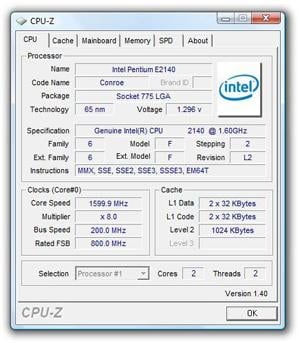Intel Pentium E2140 Dual Core Processor
Design and Features
As we mentioned before, this new Pentium utilizes Socket-775, which Intel has used for the past several years now. At first glance, this processor looks identical to the Core 2 Duo, which isn’t surprising as they are so closely linked to each other. A quick glance at the S-SPEC and surrounding codes shows the Pentium dual-core nomenclature, along with the clock speed (1.6 GHz), shared cache (1 MB), and bus speed (800 MHz). These processors should be compatible with all Socket-775 Core 2 ready motherboards on the market, although it's likely that many motherboards will require a BIOS update in order to see this new processor correctly. The chip did indeed work in all of the Socket-775 motherboards we attempted to use it in.
|
Pentium E2140 - Top
|
Pentium E2140 - Bottom
|
The E2140 runs at a native clock speed of 1.6 GHz, while Intel will also be announcing an E2160 model which runs at 1.8 GHz. The E2140 has a stock multiplier of 8x, which factors out to 1.6 GHz at a 200 MHz bus speed (800 MHZ FSB quad-pumped). The processor also supports Intel's C1E and Speedstep clock speed throttling technology, which will slow down the chip when processing loads are low. The chip will clock its multiplier down to 6x, which means that when idling, the chip will run at 1.2 GHz. At this level, the Pentium E2140 sips power and creates very little heat, running at sub-90F temperatures when idling. Even under peak loads, our chip only reached a bit over 110F with its stock cooler. In short, it runs cool, so it can be reliably cooled with near silent solutions.
The stock clock speed of 1.6 GHz isn't anything to get excited about, as Intel's high-end chips are now pushing 3.0 GHz with up to eight times the amount of cache. However, even at 1.6 GHz with 1 MB of shared cache, the Pentium E2140 was able to run Windows Vista Ultimate with all the bells and whistles. Even for moderate gaming, this processor handles the loads surprisingly well. Far better than any Celeron-class processor we've seen in the past.
CPU-Z identifies this new processor correctly, including the smaller 1 MB cache and new processor name. Here's a quick glance at the processor's spec sheet as reported by CPU-Z, if you're into that sort of thing.
|
Pentium E2140 - Core Information
|
Pentium E2140 - Cache Information
|










